Two documents released under OIA lay out the mindset and the cross-agency apparatus the government set up to monitor and record so-called ‘mis-and-disinformation’. They raise serious questions about whether or not the state is respecting citizens’ privacy and right to free speech and whether it’s treating political dissent as ‘disinformation’.
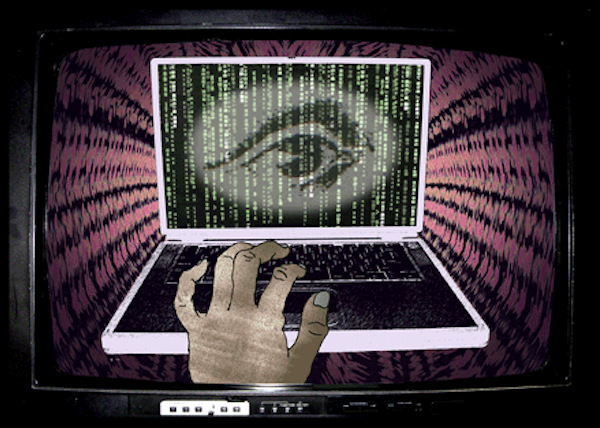
This report is long, so by way of a quick introduction, it details how the government has been monitoring alleged ‘mis-and-disinformation’. It reveals that:
* An inter-agency group was set up to track dissenting views on covid, or what the government calls ‘disinformation’, headed by the Department of Prime Minister and Cabinet.
* That a group of seven Ministers are responsible for responding to so-called ‘disinformation’.
* That the government has been concerned with creating a veneer of legitimacy through outsourcing ‘disinformation’ monitoring to academia and the private sector, lest it appears to be monitoring speech(!).
* That the now scrapped TVNZ/RNZ merger and the PJIF were part of its overall strategy to address ‘mis-and-disinformation’.
* That MBIE funded a data research project on disinformation through Te Pūnaha Matatini, at the University of Auckland, that bears a striking resemblance to The Disinformation Project.
* That New Zealand is working with Five Eyes partners to monitor and respond to what states call ‘mis-and-disinformation’, but what is also recognised as legal speech that constitutes political discourse.
The Octopus
Recently we learned of the sinister counter-disinformation units speckled across Whitehall, to monitor the British people’s sentiments around covid-19 and the government response, particularly sentiment towards vaccine passes, which never came to be adopted in the UK thanks to broad public and political opposition.
It probably won’t surprise you to know that the UK is not alone in its efforts to monitor so called mis-and-disinformation – to know and understand what YOU think about its behaviour and policies, particularly if they happen not to be the views they would prefer you to hold.
In fact, there is a Five Eyes nations-wide coordinated response with tailored activities taking place in each jurisdiction, of which New Zealand is an active participant, as revealed under the Official Information Act recently.
In the UK, however, there is now some scrutiny of this trend, thanks to Big Brother Watch’s report Ministry of Truth: the secretive government units spying on your speech. The British Prime Minster Rishi Sunak even faced some tough questions from a sitting MP two weeks ago. Can you imagine such a thing taking place in New Zealand in the present environment? We can live in hope.
Two astonishing documents from December 2020/January 2021 were released almost in their entirety on 9 December last year. A revised copy of the Department of Prime Minister and Cabinet’s briefing, Strengthening New Zealand’s Resilience to Mis/Disinformation, and the initial working draft of the Strategic Framework for Strengthening New Zealand’s Resilience to Mis/Disinformation. You can read them here.
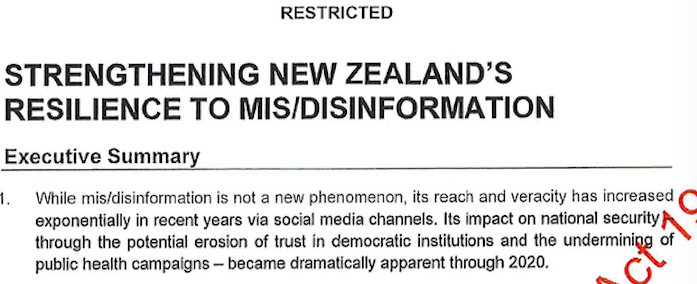
The documents lay out not just the mindset behind why our government believes it’s necessary to surveil us, but its general – terrifying – approach to doing so.
Much like Big Brother Watch’s important UK Ministry of Truth report, the documents raise alarming questions about how the government is conducting itself, under what mandate it’s operating and who is there to oversee this work and safeguard the public against overreach, mission creep and its increasingly authoritarian tendencies.
Wildly differing takes on polarising issues have been an accepted part of democratic societies for almost my entire lifetime. Why are states making a big deal about what people think now? Further, actual disinformation campaigns have been an acknowledged feature of security agencies’ modus operandi – see this 1980s documentary, which describes planting fake news reports as a standard technique for the CIA. Why are we suddenly hearing these terms ad nauseum? There is nothing new about mis-and-disinformation, just a new obsession by state actors to make us scared about it. What’s the agenda?

In fact, the briefing itself notes that the bulk of so called disinformation does not stray into illegality and is “somewhat (whatever that means) socially acceptable”, and constitutes “political discourse”. So, what the hell are they playing at?
One of the problems that becomes clear in reading these documents, is that the intention is to utilise and bring into the fold every possible arm of society – different government agencies, NGOs, academia, the private sector, the media, social media and big tech platforms and even everyday people (think of the SIS’s ‘report your neighbours’ booklet) – to monitor ‘mis-and-disinformation’ and influence how you think about it. It turns the “whole of society” into a spying, censoring and communications machine to police and control the flow of information.
Who is left to hold this octopus to account? Where are the checks and balances? Under the current set up, avenues for challenging this thinking and its real world manifestations are vanishingly thin. It can be argued that it’s an attempt at the capture of the entire mind of society, or what crisis communications and propaganda expert Greg Simons has called ‘information domain dominance’.
Orwellian overtones
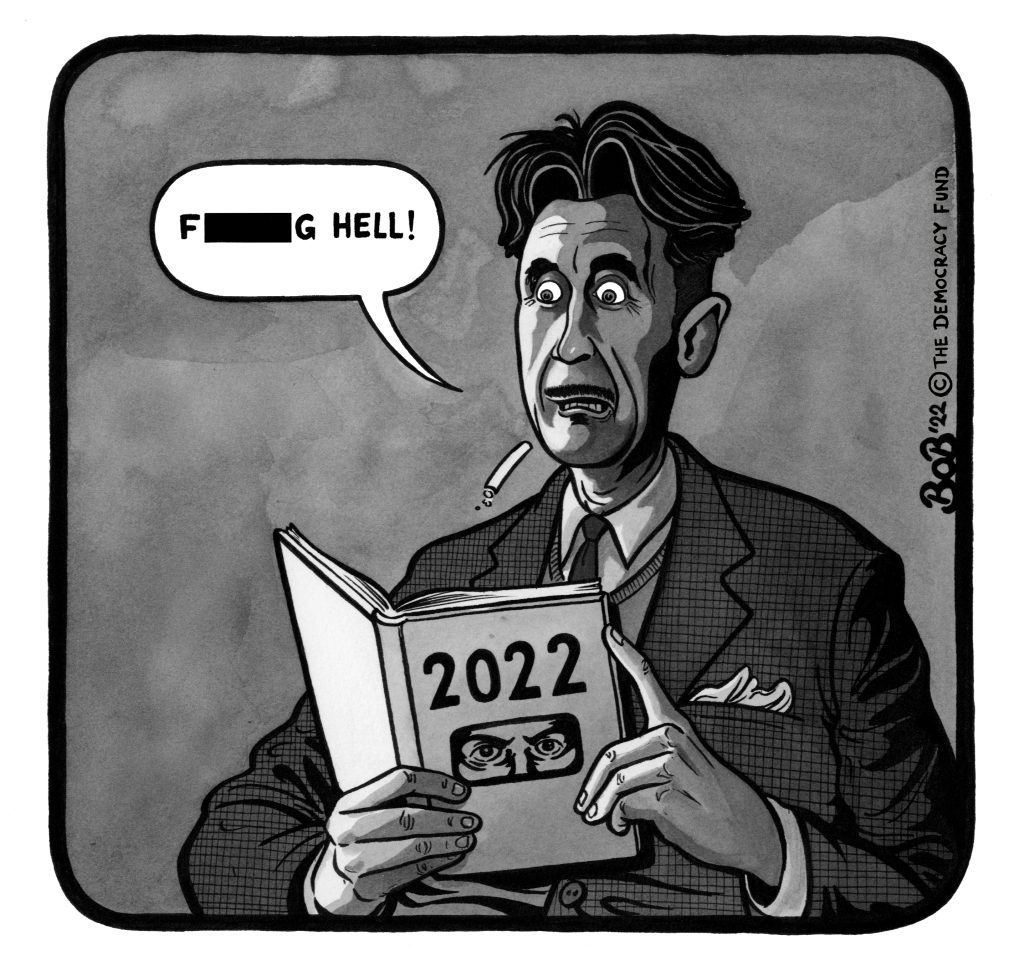
Simons is an expat New Zealander and associate professor at Uppsala University in Sweden, an expert on propaganda and crisis communications. I asked him provide some thoughts on the documents. They are what he describes as “Orwellian doublespeak at its worst.”
“What strikes me about the document[s] is the language. There is an attempt to create a moral panic through the use of specific and yet very vague language. There is a brand and reputation being created of a concept to be used operationally speaking as a bogeyman to crush any dissenting voices.”
So what do these documents, so far the most comprehensive run down of the government’s approach to the supposed ‘issue’ of mis-and-disinformation, reveal?
The inter-agency coordination group for mis/disinformation
The briefing, written for the Prime Minister, and draft strategic framework were put together as a way to seek coordinating mechanisms to address covid-19 mis-and-disinformation and to develop a strategic framework to “strengthen resilience” against it. They were previously completely restricted but after the Ombudsman was asked to investigate they were released with minor redactions in December 2022.
They reveal that New Zealand’s preferred approach was to create an inter-agency co-ordination group, with disinformation monitoring spread across different ministries, much like the UK did. The draft framework recommended that this group be headed up by the Department of Prime Minister and Cabinet, and be comprised of:
- Department of Internal Affairs
- Government Communications Security Bureau
- Ministry for Business, Innovation and Employment
- Ministry of Foreign Affairs and Trade
- Ministry of Culture and Heritage
- Ministry of Education
- Ministry of Health
- Ministry of Justice
- New Zealand Police
- New Zealand Security Intelligence Service
The documents tell us that up until this time, December 2020/January 2021, a lot of work had already been done to “understand and respond” to the problem, using academic and non-governmental research.
- The National Assessment Bureau had been producing assessments on covid-19 and election fraud ‘misinformation’
- The [covid-19] All Of Government Response Group Insights and Reporting Team had been monitoring and reporting on misinformation trends since July 2020, which was used to target “affected communities” during the August 2020 Auckland lockdown
- The Ministry of Business, Innovation and Employment was already funding covid modelling and disinformation research, a “data project”, at Te Pūnaha Matatini. It’s logical to assume this refers to the now infamous The Disinformation Project, which has had considerable media attention and influence, despite appearing from nowhere in February 2020.
The next steps, subject to agreement with the consulting agencies, was for the DPMC and the inter-agency coordination group to commence work on the draft framework to be ready by Q1 2021 for consultation with minsters.
We also know, thanks to a response to another OIA request, that this group was established after consultation and have met regularly since September 2021. The minutes of these meetings have since been requested under OIA but to date have not been released. However, a meeting agenda has.
The group has met regularly to discuss ‘disinformation’ issues and flag or escalate them to an overseeing group of Ministers. The briefing calls the strategy a “whole of society approach”, which is headed up by the Department of Prime Minster and Cabinet.
Creating a veneer of legitimacy
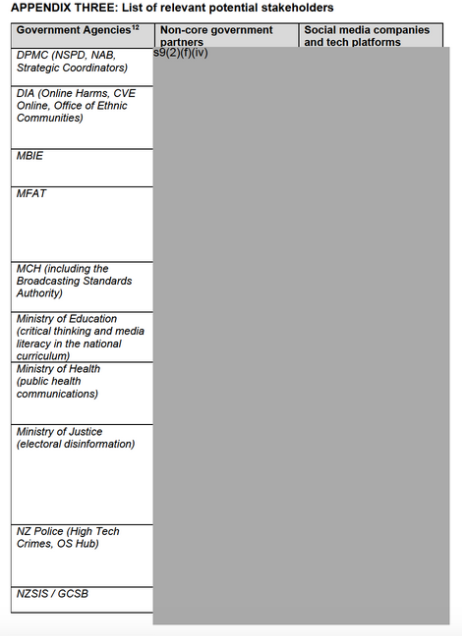
The documents suggest a certain anxiety or preoccupation that the government’s disinformation monitoring be seen as independent, and not an attempt by government at spying on the public’s legitimate communications or controlling information flows.
It’s covert approach, an attempt at obscuring the fact that it is coordinated at the very highest level of government, strikes me as paradoxical given its stated purpose is to prevent the deterioration of trust in government and media that result from “mis-and-disinformation”.
Comments like the one that follows are made repeatedly throughout:
“Ideally, efforts to counter mis/disinformation should be led from outside government from media, civil society, NGOs, academia and the private sector. Several leading academics and research organisations such as Te Pūnaha Matatini, other organisations such as Netsafe and InternetNZ have already been very active and we are exploring how to support them and lift their capacity in this work.”
While the language is fuzzy, it remains a rather frank admission that the deliberate decision to delegate at least some disinformation monitoring to non-government partners – in particular universities and private sector organisations – is to maintain a veneer of legitimacy. The briefing states:
“Oversight of mis-and-disinformation is a sensitive issue, as any public commentary or perceived control of a ‘counter-disinformation effort’ can reinforce conspiracy meta-narratives about state manipulation of information and give legitimacy to those claiming an erosion of free speech. For this reason we would not recommend a formal allocation of disinformation responsibilities or the identification of a government spokesperson. A group of relevant Ministers with whom significant issues can be highlighted and public communications approaches approved, will however, be important to ensure appropriate proactive oversight of official activity in this area.”
This stance, it’s stated, stems from international experience that directly addressing mis-and-disinformation through official spokespeople leads to a lack of public trust – or as it’s phrased in the briefing, “lends legitimacy to the message/messenger” that can “reinforce government conspiracy narratives.”
This may explain why specific instances of mis-and-disinformation are never identified in public communication campaigns, and only implied. This makes it easy to cast aspersions without debating facts, which could leave the government exposed as being wrong, or even as having lied.
As it turns out, at least one government monitoring unit, DART, was created. The unit sat within the Ministry of Health to monitor covid-19 disinformation on a day to day basis. I’ll cover that a bit further on.
Ministers of Truth
Under this “whole of society” setup, which is a euphemism for cross-agency, cross-sector coordination, a group of Ministers are responsible for disinformation issues collectively. Issues are flagged or escalated to them by the inter-agency coordination group.
When journalist Tova O’Brien said last year that “New Zealand needed a Misinformation Minister“, she needn’t have worried – there are seven of them.
If this group still exists, as of early 2023 after the resignation of Jacinda Ardern, and under the newly appointed Prime Minister and allocated portfolios, this group comprises the following Ministers:
Prime Minister/Minister for National Security and Intelligence, Chris Hipkins
Strategic communications for the inter-agency group is headed up by the DPMC. Mis-and-disinformation are said to impact national security risks and have implications for other work streams including countering violent extremism and foreign interference and there is a concern that mis-and-disinformation undermine trust in government and public health campaigns.
Minister of Education, Jan Tinetti
Education programmes are viewed as a key avenue for strengthening resilience to disinformation. A new focus, alongside science and numeracy literacy, is “critical thinking and media literacy”. The draft framework notes that “Two of the key tools for building resilience to disinformation will be through the effective coordination of clear and proactive public communications, and a focus on longer term education and social inclusion that leverages work already underway in schools around active citizenship and online safety.”
It’s also worth noting these documents contain references to two terms that were uncommon until very recently – ‘infodemic‘ and ‘prebunking’. Both terms were coined at the UN/WHO level. Prebunking is one of the tools authorities want to promote within the education environment as an aid to “critical thinking”, but is little more than behavioural psychology nudging. In a recent Reclaim the Net article, prebunking is described as “precrime’s little cousin”.
The types that promote this concept argue that “innoculating” against disinformation is better than debunking it later. What this really means is that nudging is preferred over open frank discussion in which you might have to present facts and back them up.
Minister of Health, Ayesha Verrall
With MOH as the lead agency for the covid-19 vaccine roll-out, it is seen as playing a key role in monitoring disinformation narratives about the injection. The Disinformation Assessment and Response Team (DART) was set up within the MOH’s immunisation programme, described in one official email as “the only function in government looking at disinformation on a day to day basis.” It has since been decommissioned.
Minister responsible for GCSB and NZSIS, Andrew Little
Because disinformation narratives may be generated by and/or spread by state actors, intelligence agencies will play a key role.
Minister of Broadcasting and Media, Willie Jackson
Under this draft framework, the Minister for Broadcasting and Media, along with the Minister for Internal Affairs worked together to scope a review of content regulation, which is considered to overlap with disinformation. The review was aimed at “addressing gaps” in current regulation. The Broadcast and Media Minister is also responsible for “building a stronger independent media” that could assist with counter-disinformation.
“This includes the Strong Public Media Programme which is assessing the viability of establishing a new public media entity and the Investing in Sustainable Journalism initiative which aims to protect public interest journalism.”
Minister of Internal Affairs, Barbara Edmonds
In addition to scoping the potential review of media content regulation, the Minister also has responsibility for the Official Digital Saftey (including Countering Violent Extremism online), the Films, Videos and Publications Classification Act, and setting and monitoring the strategic direction of independent Crown Entity the Office of Film and Literature.
Minister for the Digital Economy and Communications, Ginny Anderson
Because they are responsible for the digital safety work programme, which includes efforts to counter a range of online harms and promote online safety.
Funding of disinformation monitoring
The funding for this work is spread across the agencies in the inter-agency group, and is indicated to have been an area of contention at times. However, the draft framework reveals that MBIE funded disinformation research undertaken by Te Pūnaha Matatini to help inform the covid-19 communications strategy. It also allocated additional funding to an NGO, the name of which was redacted.
It further elaborates that:
“MBIE provided funding to Auckland University for research into New Zealand’s epidemic model, including a data project by Te Pūnaha Matatini on social media based covid-19 related disinformation.”
This must surely be the infamous The Disinformation Project, the funding for which has remained officially obscured, although not seriously debated. The project is clearly a government directed activity, as this brief makes clear.
Co-opting the media: TVNZ/RNZ merger and PJIF
The documents note that media ‘campaigns’ against mis-and-disinformation from outlets like Stuff, Newsroom and The Spinoff have been helpful in the government’s overall counter-disinformation efforts.
“These independent narratives are especially welcome and helpful as they are less likely to be associated with conspiracy theories about state control than if they came from a government agency.”
Some might say Google funded fact checking initiatives, such as Stuff’s The Whole Truth, don’t really count as ‘independent’ journalism, although it may technically be independent from government.

It’s worth noting that one of the Ministers with oversight of ‘disinformation’ monitoring is the Minister for Broadcasting and Media.
These documents reveal, as noted above, that a) the establishment of a new public media entity; and b) investing in public interest journalism were part of this disinformation strategy. The government has not exactly been transparent about this objective, and despite waffly language about strengthening independent media, both of these moves clearly makes media more dependent on government – not less. Orwellian doublespeak indeed.
The Public Interest Journalism Fund, established in February 2021 with a $55m government allocation to NZ On Air, has always been controversial among that segment of the population sceptical about the government’s covid narrative because it was seen as a way of buying media compliance. The proposed TVNZ/RNZ merger (the new media entity they hoped to establish) was scrapped just weeks ago in the post-Ardern policy bonfire, after failing to win favour with media entities themselves, not least because of concerns around editorial independence.
Despite these initiatives not kicking in until 2021 (PIJF) and 2022 (media merger announced), this revelation makes it much less of a coincidence that media have been completely ‘on-narrative’ from day one of the covid situation, and certainly goes some way to explaining why they have never broken ranks.
Just as disinformation monitoring was being funded prior to this draft framework’s existence, it’s hard to believe there were no levers of influence used to steer editorial policy in the early days of the pandemic, especially because there was no substantive questioning of any part of the covid story even at the beginning.
We know that The Disinformation Project intended to run private workshops last year – grooming sessions – with journalists on the topic, cancelled only because of unwanted independent media attention about how dystopian it all was.
Another major arm of the strategy’s media component was scoping a review of media content regulation to assist on the issue of disinformation – basically looking for ways to tighten up on what people can and can’t say. This was delegated to the Department of Internal Affairs and the Department of Culture and Heritage.
This was progressed, and in 2021 the DIA commissioned Associate Professor Peter A. Thompson and Senior lecturer Michael S. Daubs from the Media and Communication programme at Victoria University of Wellington to undertake a research study on current international developments to regulate harmful content. The timeframe of analysis for this research report was July 2021-November 2021. You can read it here.
The ultimate destination of the review is new regulation that would echo the UK’s Online Safety Bill and Canada’s newly passed online censorship Bill.
DART: Ministry of Health’s disinformation monitoring
We know that subsequent to these documents, within the Ministry of Health the Disinformation Assessment and Response Team (DART) was established as part of its immunisation programme. DART produced regular, even daily ‘Disinformation Landscape Reports’ and in May 2022 a ‘Disinformation Harms Report’ for the DPMC.
OIA requests have revealed DART ran a triage system and dashboards for disinformation in New Zealand from around March 2022, disclosed in emails to Netsafe. DART proposed working with Netsafe, using its triage system to pass on direct reports of ‘mis-and-disinformation’, provide access to its dashboard and to generally collaborate on work, including Netsafe helping DART with analysis and understanding the wider digital space.
An email from a DART senior advisor to Netsafe noted that: “Also, as Netsafe is an independent body this ensures an impartial filter on issues noted by DART, as in most cases Netsafe would be the first port of call for such, and that is something which is of value to DARTs work (we do not want to be seen as some form of internet police).”
According to another OIA response, DART transferred into the Communications and Engagement Group (to the Office of the Director General Information, an executive role that does not appear on the MOHs publicly listed executive team) in June 2022 and was rescoped to fit with the communications focus.
In emails between DART and the cybersecurity agency CERT NZ (part of MBIE), DART is described as originally being an all of government clearinghouse for disinformation, but once transferred to the ODG, was reduced to health focus only.
Computer Emergency Response Team (CERT) was established in 2016 to join an international network of CERTs that receive cyber incident reports and track cyber security incidents. CERT worked with DART BY routinely passing on any information of public reporting on ‘disinformation’ to DART, in the form of a spreadsheet.
Listed on the spreadsheet are Voices For Freedom flyers such as “Are you being mask winked?”, and an email sent to Oromahoe School by a member of the public containing links to published studies showing that masks harm children, among other items. CERT did not assess these items to classify them as disinformation, but passed them on to DART for assessment.
The OIA shows that in September 2022, after a long period of deliberation, the MOH decided not to take over the collection of public reporting of ‘disinformation’ from CERT. An email from the DART senior advisor to CERT NZ stated:
“I can assure you this is not the outcome I wanted and certainly not the timeframe I had hoped but in the end the decision went all the way to the top and has seen even DARTs fate remain uncertain as there is still no full signing of the memo regarding DART and it’s been repeatedly chopped and changed so our function, staff and budget is only til the end of the year. The only thing that is known is that DART with remain within MOH til the end of the year but after that there is no certainty and that is how things have played out despite my best efforts to make it work.”
An OIA request also established that DART was monitoring BFD journalist Cam Slater and that the team was disbanded in the last two months of last year. It consisted of two contractors and one senior advisor.
International coordination
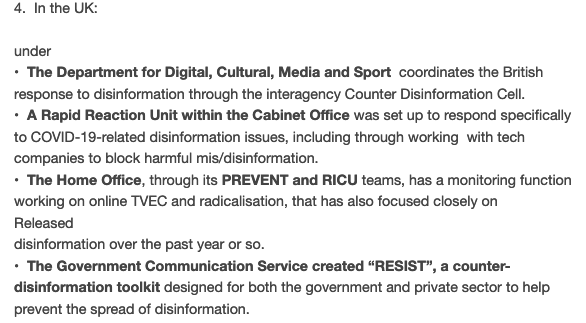
The briefing documents make clear that international co-ordination is taking place, as is to be expected as part of Five Eyes, and as news headlines are increasingly reinforcing.
“New Zealand has received multiple bilateral and multilateral requests to share information about Covid-19 related mis/disinformation, and we expect that likeminded partners will increase offers to work together on further actions, statements or attributions relating to disinformation. Developing a stronger domestic approach to mis/disinformation would effectively and credibly support these international engagements,” the briefing document states right up front.
Then, in the draft framework, it’s noted that:
“Amongst our closest security partners, work to counter disinformation is coordinated by a
number of different agencies, and responses vary from state-controlled counter-narratives
through to funding civil-society initiatives. This work is evolving very quickly and, as such,
below is only a very brief snapshot of the various parts of Five Eyes’ governments that
are addressing the issue of mis/disinformation. We will be engaging more closely on this
issue in 2021 to learn more about partner approaches.”
It then lists the counter-disinformation units set up in other Five Eyes countries, including some of those exposed in Big Brother Watch’s Ministry of Truth report.
‘Fusion cell’
Due to limited resources in the Department of Internal Affairs and the Department of Prime Minister and Cabinet, the briefing suggests two options for ongoing monitoring of mis-and-disinformation (Remember this is in December 2020. The Disinformation Project was set up in February 2020 within Te Pūnaha Matatini so some form of monitoring had been in place since the start of the covid situation).
One suggestion was a ‘fusion cell’, potentially housed within the DIA, the other was the option of procuring services from outside the government to monitor and report on the social media environment. “There are some universities and think tanks that have the capacity to do this for us,” it notes.
Again, is this a reference to The Disinformation Project? Which other think tanks?
A mixture of both options is another suggestion, in which social media monitoring is preferably done by non-government actors, again to avoid reinforcing ‘conspiracy theories’ about state control. This last option appears to be what was implemented.
Was DART the fusion cell? We know it was working with CERT NZ and Netsafe and monitoring a journalist. What else was it doing?
Building social license and influence
As mentioned earlier, the briefing itself notes that the bulk of so called disinformation does not stray into illegality, is “somewhat socially acceptable”, and constitutes “political discourse”, but points out that instances can cross over into illegal activity such as incitement to attack cell towers.
It recommends the inter-agency group establishes a threshold that would require “a more direct response”. This might include election meddling or attempts at radicalisation, it’s suggested.
Remarks were made about the need to bring the public along so that people are comfortable with this level of information monitoring.
Has said threshold been established? If so, what is it? Surely the public deserves to know. Particularly in light of a stunning piece of modern day book burning that involved The Disinformation Project and a Stuff reporter that used this very line – that some disinformation can stray into illegality – to have New Dawn magazine removed from the shelves at Whitcoulls and supermarkets. It deserves it’s own report from TLG, because it was based on a heady piece of disinformation itself – but you can read a good write up here.
21st Century Wire reporter Patrick Henningsen writes: “The level of speed and coordination in this operation is nothing short of breathtaking.”
Little wonder when you have an information monitoring and, let’s face it, influence apparatus in place that makes 20th Century censorship look amateur.
Greg Simons’ analysis is that by claiming there is a terrible threat that can potentially destroy our values and society the government can then “act urgently”, with a strict and comprehensive regime of censorship, to ‘protect’ us. This is an element used in crisis communication, in which a predetermined political solution or remedy is offered to a frightened public.
“In another words, any information that does not adhere to the ‘officially approved’ government narrative will be squashed in the name of protecting democracy and the public. The result shall be an attempt at information domain dominance as a means to shape public consensus through the strict conformity of speech and expression.”
He used the example of Russian media being banned in the EU, and how it was justified as being good for the information sphere.
“The information realm will be strictly cultivated as a means of attempting to control and shape the cognitive realm of the public. 1984 shall look like child’s play,” Simons said.
What should the public make of all this?
So what has come of this briefing and draft framework?
We are being asked to take it on trust that those raising the alarms about mis-and-disinformation – the intelligence agencies – have our best interests at heart and are not in the pocket of globalised interests, public or private (because hell, who can tell the difference anymore). But who polices the spies?
They admit the bulk of what they class as disinformation is legal, and constitutes political discourse. Why such a massive political exercise then, to monitor and find ways to curb it?
And if the public are both the target of its influence, and the potential scapegoats (anyone can now be flagged as a security threat, a domestic extremist, by falling foul of the security state’s acceptable information parameters) what kind of dangerous power dynamic is being put in place? Has already been put in place?
In my view, the briefing goes some way to explaining the fact that New Zealand had much less open debate about the covid response than the UK did, and consequently policies that went much further – injection mandates and vaccine passes were not introduced in the UK due to public pushback, for example. Here, the pushback was silenced, ridiculed and suppressed at the willing hands of just about every public institution, including the ‘watchdogs’ and the fourth estate.
With all the bases covered through ‘inter-agency coordination’, was true open and free debate killed at the starting block of the whole covid situation? Observation and lived experience would suggest that is the case.
Three years in and everyday people have done a lot of groundwork and fighting back, but there’s nothing out there like Big Brother Watch to champion criticism of this overreach or point out publicly that we have no safeguards in place to protect us from government “mission creep”, except for perhaps the Free Speech Union.
Incidentally, its UK forerunner and counterpart was one of the targets of intelligence monitoring as laid out in the Ministry of Truth report. Listen to Canadian veteran reporter and investigator Trish Wood interview the UK Free Speech Union’s founder Toby Young about it here.
The briefing paper and draft framework does a lot of heavy lifting for us, however, shedding some significant light on the approach taken by our Government and the thinking behind their choices.
Holding Ministers and officials to account on behalf of voters requires scrutinising claims and purported evidence that was used to lock us down, mandate injections and all the other draconian stuff that has gone on. We need to be able to do this without being covertly monitored, censored and propagandised by those in power.
This article was updated on 5 May 2023.